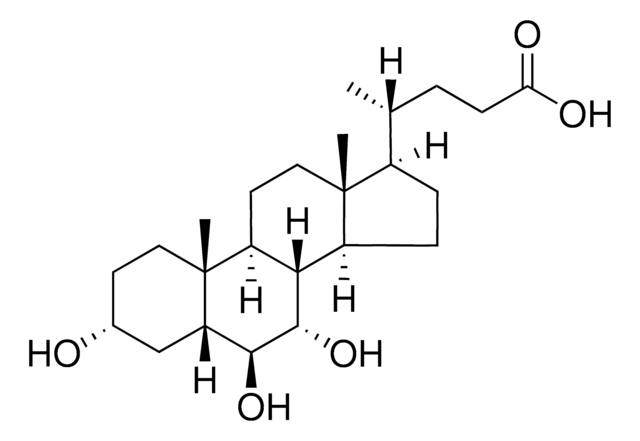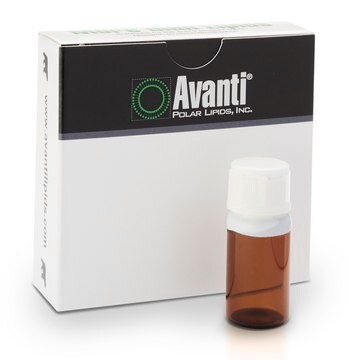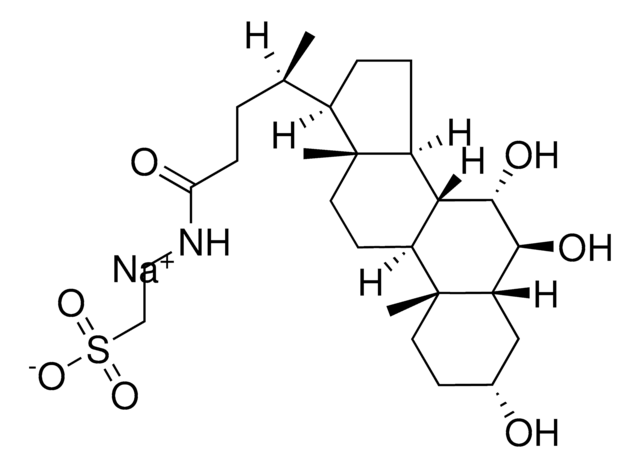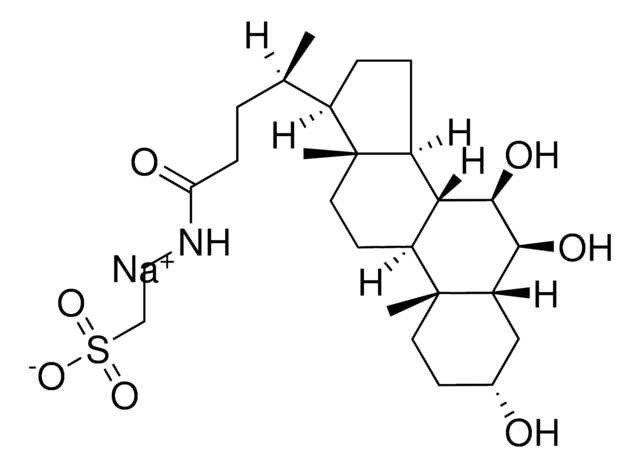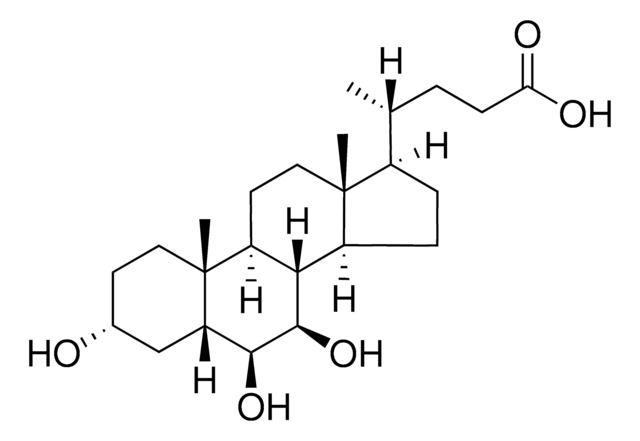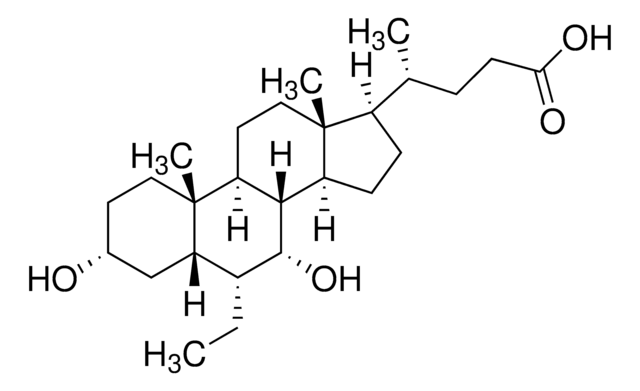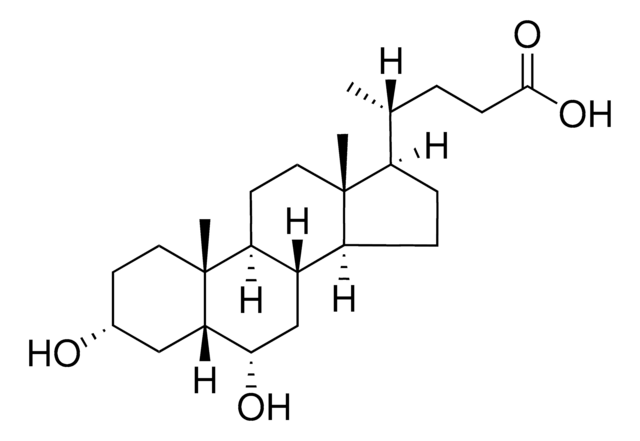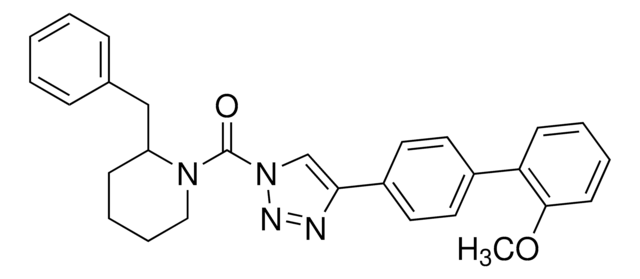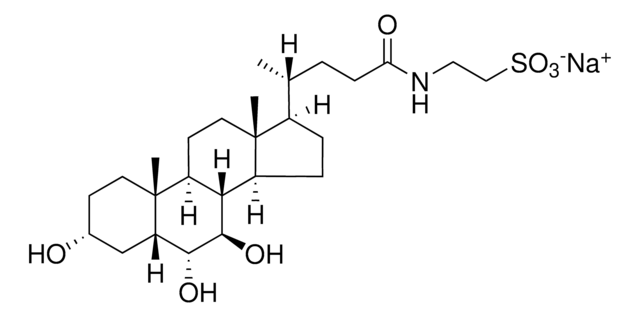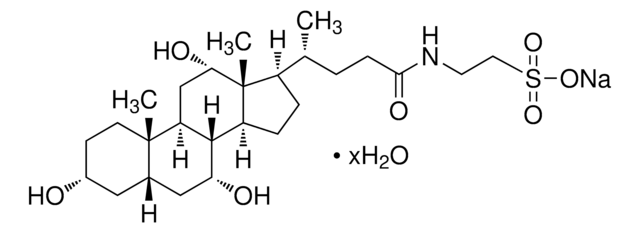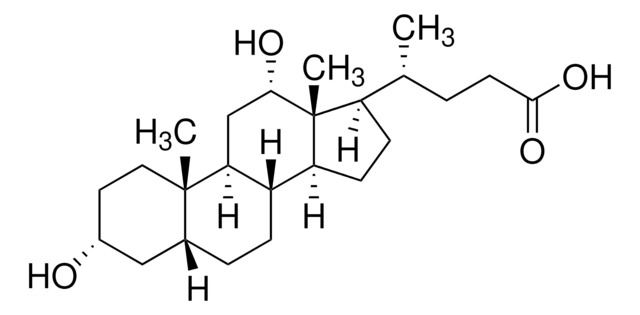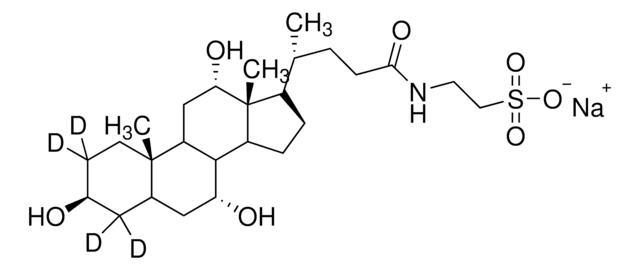おすすめの製品
アッセイ
≥98% (HPLC)
フォーム
powder
光学活性
[α]/D +59 to +65°, c = 0.5 in methanol
色
white to beige
溶解性
DMSO: 2 mg/mL, clear
保管温度
−20°C
InChI
1S/C24H40O5/c1-13(4-7-19(26)27)15-5-6-16-20-17(9-11-23(15,16)2)24(3)10-8-14(25)12-18(24)21(28)22(20)29/h13-18,20-22,25,28-29H,4-12H2,1-3H3,(H,26,27)/t13?,14-,15?,16?,17?,18+,20?,21+,22-,23-,24-/m1/s1
InChI Key
DKPMWHFRUGMUKF-CWNVCPLQSA-N
アプリケーション
β-Muricholic Acid has been used as a bile acid to study its effects on the expression of pluripotency, stemness, and inflammatory genes in primary mouse hepatocytes (PMH) and tumor-initiating stem-like cells(TICs). It has also been used as a bile acid to study its effects on gut transit ingnotobiotic or conventional mouse models.
生物化学的/生理学的作用
β-Muricholic Acid is a naturally occurring trihydroxy hydrophilic bile acid that is produced in the liver of murine. It serves as a biliary cholesterol-desaturating agent and aids in the dissolution of cholesterol gallstones.
β-Muricholic acid (β-MCA) is a natural murine-specific bile acid. β-Muricholic acid has been shown to reduce the absorption of cholesterol. It also has some activity as a farnesoid X receptor antagonist.
保管分類コード
11 - Combustible Solids
WGK
WGK 3
引火点(°F)
Not applicable
引火点(℃)
Not applicable
適用法令
試験研究用途を考慮した関連法令を主に挙げております。化学物質以外については、一部の情報のみ提供しています。 製品を安全かつ合法的に使用することは、使用者の義務です。最新情報により修正される場合があります。WEBの反映には時間を要することがあるため、適宜SDSをご参照ください。
Jan Code
SML2372-VAR:
SML2372-BULK:
SML2372-25MG:
SML2372-5MG:
最新バージョンのいずれかを選択してください:
この製品を見ている人はこちらもチェック
Xiaobei Pan et al.
Metabolites, 7(2) (2017-06-21)
Certain endogenous bile acids have been proposed as potential therapies for ameliorating Alzheimer's disease (AD) but their role, if any, in the pathophysiology of this disease is not currently known. Given recent evidence of bile acids having protective and anti-inflammatory
Kyosuke Fujita et al.
Lipids, 52(4), 335-344 (2017-03-21)
The farnesoid X receptor (FXR) is a major nuclear receptor of bile acids; its activation suppresses sterol regulatory element-binding protein 1c (SREBP1c)-mediated lipogenesis and decreases the lipid contents in the liver. There are many reports showing that the administration of
Laura Conde de la Rosa et al.
Journal of hepatology, 74(6), 1429-1441 (2021-01-31)
Besides their physiological role in bile formation and fat digestion, bile acids (BAs) synthesised from cholesterol in hepatocytes act as signalling molecules that modulate hepatocellular carcinoma (HCC). Trafficking of cholesterol to mitochondria through steroidogenic acute regulatory protein 1 (STARD1) is
David Q-H Wang et al.
Journal of lipid research, 43(11), 1960-1968 (2002-10-29)
This study investigated whether beta-muricholic acid, a natural trihydroxy hydrophilic bile acid of rodents, acts as a biliary cholesterol-desaturating agent to prevent cholesterol gallstones and if it facilitates the dissolution of gallstones compared with ursodeoxycholic acid (UDCA). For gallstone prevention
Ylva Bonde et al.
PloS one, 11(1), e0147772-e0147772 (2016-01-30)
High endogenous production of, or treatment with muricholic bile acids, strongly reduces the absorption of cholesterol. Mice abundant in muricholic bile acids may therefore display an increased resistance against dietary induced weight gain, steatosis, and glucose intolerance due to an
ライフサイエンス、有機合成、材料科学、クロマトグラフィー、分析など、あらゆる分野の研究に経験のあるメンバーがおります。.
製品に関するお問い合わせはこちら(テクニカルサービス)